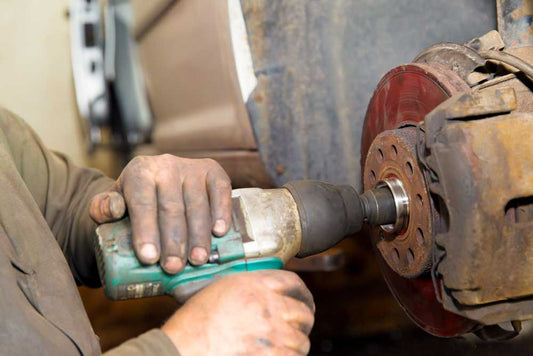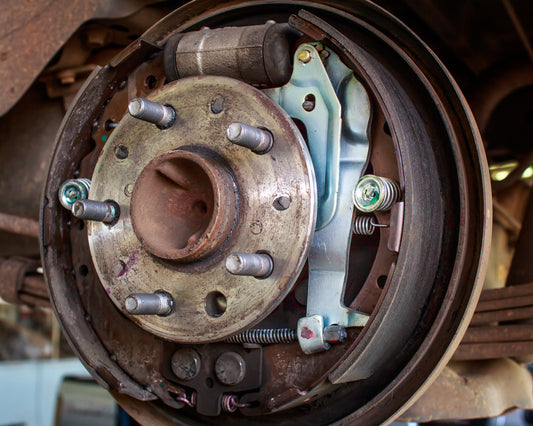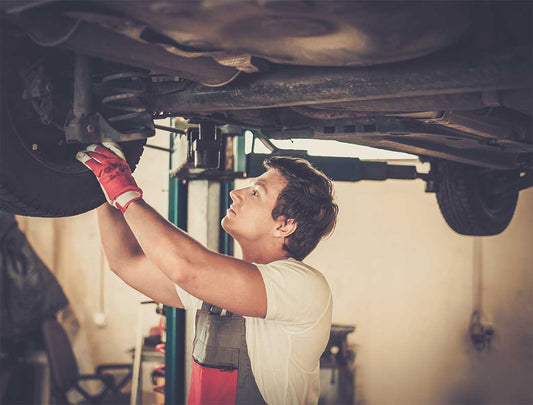Problem
Brake pull occurs when a vehicle pulls to one side or the other during braking.
Cause
Depending on several variables, there are a variety of potential causes for brake pull. For example, most of the common causes have been listed below:
- Friction problem
- Rotor friction surface problem
- Caliper problem
- Restricted brake hose
- Hydraulic restriction higher than brake hose
- Rear brake imbalance
- Loose front end part
- Alignment
- Tires
Solution
Determining the actual cause of the pull condition relies on methodically approaching the problem. When faced with a brake pull condition, follow these steps:
1. Confirm Brake Pull
First, drive the vehicle on typically crowned roads. Next, take note of how the vehicle handles both braking and non-braking. If you notice any brake pull, proceed to the next step.

2. Test more parts to rule out brake pull
Before jumping to conclusions, it is essential to check tire size, condition, and air pressure. If any tires are not within acceptable levels, side to side swap tires accordingly and road test the vehicle. Otherwise, if the pull is still present, go to the next step.
3. Inspect steering and suspension
Pay close attention to any part that will allow a toe or caster change during braking. If any component shows excessive wear that could contribute to the pull, the repair is suggested before continuing. Otherwise, if all front-end parts are tight, go to the next step.
4. Line lock test
Line lock rear brakes with approved line lock. Test drive vehicle to check if the pull is affected. If the pull is gone, the cause is in rear brakes. If the pull is still present go to the next step.
5. Brake Inspection for brake pull
Pay close attention to the operation of the calipers. Check caliper housing’s ability to move freely. Next, check piston condition by pulling back dust boot to see if a significant difference exists from side to side service calipers and road test vehicles. If the pull is still present, go to the next step.
6. Swap brake pads
In the case that the front pads have friction material left on them, swap brake pads from side to side and test drive the vehicle. If the pull is gone or switches, directions friction is the source of your problem. If there is no change in the pull, swap the brake pads back to their original position and go to the next step.
7. Swap Rotors
With brake pads back to their original position, swap rotors, and test drive vehicle. If the pull is gone or switches sides rotor’s friction surface is the cause. If there is no change in the pull go to the next step.
8. Brake pull Side-to-side pressure check
If pressure gauges or clamping plate gauges are available, perform aside to side pressure check. Pressure readings should be within 50psi at a pressure above 500psi. If pressure readings are not within 50psi of one another, go to the next step, or if pressure gauges are not available to proceed to the next step.
9. Determine brake pull restriction points
Determine possible points of restriction. On a front to rear split hydraulic system this will include the brake hose, ABS modulator (if equipped), and combination valve (rare but possible), and steel brake line to the side opposite the direction of the pull. If the diagonal split hydraulic system, the list will include brake hose, ABS modulator (if equipped), steel brake line to the side opposite the direction of the pull, and master cylinder.
10. Brake hoses and brake pull
The most common point of restriction is the brake hoses. The hose on the side opposite the direction of pull is the most likely cause. If the hose has a mounting bracket clamped around it, check the bracket for signs of corrosion. When corrosion is present, pry the bracket apart, squeeze the hose in the direction opposite the crushed pattern and then test drive the vehicle.In the case that the pull is eliminated or substantially reduced, the brake hose is the cause. If no external signs of restriction are visible, the decision must be made to replace the hose(s) or perform additional diagnostic steps. Those steps could include switching hoses from side to side or blowing through both hoses to check if there is a difference.Usually, the time necessary to do either test would be better spent trying a new set of hoses. If the hoses are shown not to cause the pull by diagnosis or replacement, the system should be checked for an upstream restriction. Go to the next step.
11. Hydraulic components
Brake pull still present after performing steps 1 to 10 – This should not happen very often. If you followed steps 1 to 10 correctly and the vehicle is still exhibiting a brake pull, identify hydraulic components between the master cylinder and front brakes.These will usually include the ABS modulator and/or the combination valve. On vehicles equipped with combination valves, the outlet lines of the valve can switch using the necessary line adapters to determine if the valve is the source of restriction. If the pull is still present after step 11, it is advisable to recheck previous actions.

More Tips and Tricks
Looking for more mechanical tips? Check out our Facebook page "Mechanic Mafia" to connect with mechanics with various backgrounds. Otherwise, click the "More Articles" button below for more tips and tricks.
Facebook Group
More Articles




